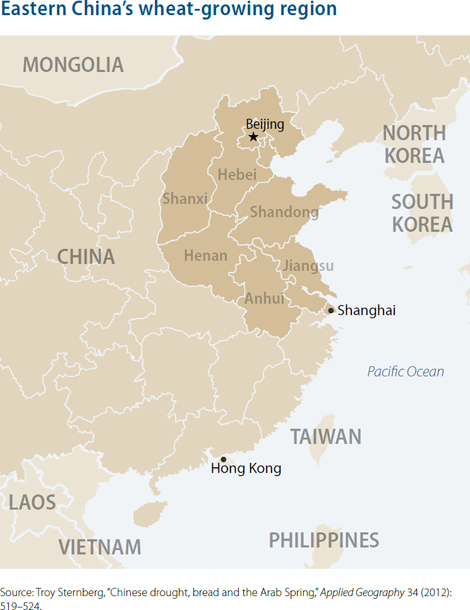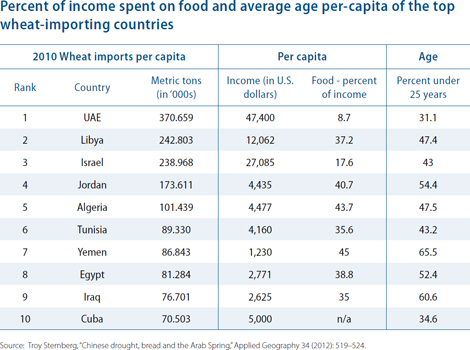Chinese Drought, Wheat, and the Egyptian Uprising: How a Localized Hazard became Globalized
25 Apr 2014
By Troy Sternberg for Stimson Center
This article was originally published in The Arab Spring and Climate Change, which can also be accessed here.
Chinese drought, global wheat prices, and revolution in Egypt may all appear to be unrelated, but they became linked by a series of events in the 2010–2011 winter.[1] As the world’s attention focused on protests in Egypt’s Tahrir Square, political and socioeconomic motives behind the protests were discussed abundantly, while significant indirect causes of the Arab Spring received little mention. In what could be called “hazard globalization,” a once-in-a-century winter drought in China reduced global wheat supply and contributed to global wheat shortages and skyrocketing bread prices in Egypt, the world’s largest wheat importer.[2] Government legitimacy and civil society in Egypt were upset by protests that focused on poverty, bread, and political discontent.
A tale of climate disaster, market forces, and authoritarian regimes helps to unravel the complexity surrounding public revolt in the Middle East. This essay examines the link between natural hazards, food security, and political stability in two developing countries—China and Egypt—and reflects on the links between climate events and social processes.
The aforementioned citizen protests in Egypt represented political and economic dissatisfaction, including the high cost of food—recall the days of waving bread as a protest symbol.[3] Bread provides one-third of the caloric intake in Egypt, a country where 38 percent of income is spent on food.[4] The doubling of global wheat prices—from $157/metric ton in June 2010 to $326/metric ton in February 2011—thus significantly impacted the country’s food supply and availability.[5]
The world wheat harvest was affected by changing weather patterns in 2010 that led to supply shortages. Climate factors curtailed wheat production in Russia (down 32.7 percent) and Ukraine (down 19.3 percent) due to drought, heat waves, and fires, while cold and rainy weather in Canada (down 13.7 percent) and excessive rain in Australia (down 8.7 percent) resulted in reduced global wheat supply and major price increases. At the same time China’s wheat production fell 0.5 percent, while wheat consumption in the country increased by 1.68 percent.[6]
China, the largest wheat producer and consumer in the world, experienced drought in its growing eastern region in November 2010.[7] Fears of potential crop failure and the specter of historical famines—most recently in 1958–1961—led the Chinese government to purchase wheat on the international market to compensate for losses from drought.[8] A fraction (6 percent to 18 percent) of annual global wheat production is traded across borders, so any decrease in world supply contributes to a sharp rise in wheat prices and has a serious economic impact in countries such as Egypt, the largest wheat importer in the world (9.8 million metric tons in 2010).[9]
Climate conditions put market pressure on international wheat prices, which were further exacerbated by a lack of precipitation in China. This threatened the 2010–2011 winter wheat crop—a crop that accounts for 22 percent of the country’s harvest. Examination of the drought record at 12 sites in China’s eastern wheat belt—including Shandong, Henan, and Anhui provinces, with a combined population of more than 300 million—using the Standard Precipitation Index, or SPI, which tracks the dramatic extenuation of drought in China’s eastern region. (see Table 1) The index examines precipitation anomalies at selected meteorological stations to identify the spatial and temporal extent of drought.[10]
With data from the China Meteorological Administration, the SPI was used to calculate drought on a monthly timescale. The findings documented extreme drought across the region, reaching once-in-a-century levels. Drought severity affected domestic and agricultural water supply, closed parts of the Yangtze River to shipping, dried reservoirs, and reduced hydropower generation, prompting a strong government response to the disaster.[11] The rarity of the event contributed to its potentially significant agricultural and socioeconomic impact and prompted dramatic photographs of Chinese Premier Wen Ji Bao watering the wheat fields with a garden hose and military rocket launchers “shooting the clouds” to bring rain.[12]
Discussion
The 2011 extreme drought in the Chinese wheat-growing region exemplifies how a regional climate event can have both a regional and a global impact. Potential wheat crop failure contributed to a series of government actions that influenced economic and political conditions in other regions of the world. China’s drought mitigation effort—including $1.9 billion in new water infrastructure and the purchase of wheat from external markets—contributed to the skyrocketing cost of wheat for importing countries.[13]
This is particularly pertinent to Egypt, a country that spends 3 percent of its gross domestic product on wheat subsidies and that experienced the 1977 “bread intifada” that killed 77 people and the bread riots in 2008.[14] Higher wheat prices affected the cost and availability of bread in Egypt, influenced citizen protests, and indirectly led to regime change in Egypt. This chain of events and actions highlight how government effectiveness—or lack thereof—in two autocratic regimes resulted in opposite outcomes and reflects how in today’s interconnected world, natural hazards can influence economic (price), political (government stability), and human (food supply) systems on an international scale.
Climate
As stated above, we have reached the point where a regional climate event can have a global extent.[15] Impact is no longer limited to physical damage at a disaster’s epicenter. Rather, it can also be social and economic, as hazards affect globalized systems. Recent disasters, including tsunamis in Asia and volcanic eruptions in Iceland, reflect the cross-border effect of natural hazards. Hydrometeorological disasters predominate today and occur at a greater rate than geophysical events.[16] Future shifts in climate patterns (cooling or warming), seasonality (fluctuation in precipitation/temperature patterns and occurrence), intensity, and volatility can significantly impact the environment, agriculture, water supply, and livelihoods.
In this study, a series of droughts and rain episodes in one region in 2010–2011 had economic and then political effects thousands of miles away. Such unfolding progressions are more commonly evaluated when events affect oil prices, famine, migration, or terrorism—for example, conflict, the Iraq war, drought in the Horn of Africa—but similar scenarios are likely to be repeated as climate volatility, expanding populations, and competition for resources disturb global markets and possibly national stability.
Geography
The geography of the two countries contributes to their dependence on climate factors, as both Egypt and China are predominantly arid nations. Egypt’s climate limits its ability to expand grain production to satisfy the requirements of an expanding population. Throughout the Nile region, there is competition for farmland and water between urban centers and agrarian interests, as well as between high-value exports crops such as flowers and mangoes, and staple foods such as wheat. Failing to meet domestic demand left Egypt exposed to external forces (climate, economics) and reliant on changing international commodity markets.
China’s western and northern regions are predominantly drylands—the country’s large population and agricultural production is centered in the eastern and southern regions. Currently this area has enough land, water, and technology for domestic wheat production to be self-sufficient in most years. Yet water resources are concentrated in the south and strong finances and continued government effort are required to develop agricultural resources elsewhere and mitigate the hazards of such reliance on a single growing region.
Both countries’ governments have attempted to balance agriculture, finances, and food supply with public needs. In 2011 China succeeded, while the former Egyptian regime failed.
Future Implications
The effect of climate hazards on wheat production in 2010–2011 is a striking case of how hazards, agriculture, economics, and politics can become intricately linked. As protests spread across North Africa and the Middle East, it is interesting to consider the percent of income spent on food and the average age of the world’s major wheat-importing countries per capita. (See Table 2)
One instantly notes that the top nine importers are all in the Middle East; seven had political protests resulting in civilian deaths in 2011.[17] Households in the countries that experience political unrest spend, on average, more than 35 percent of their income on food supplies.[18] This contrasts starkly with developed countries such as the United States and the United Kingdom, in which households spend less than 10 percent of income on food. Conditions reflect the dependence of Arab nations on imported food and their vulnerability to fluctuating global commodity markets.
As global wheat prices doubled, pressure on domestic bread prices increased in the region and influenced public dissatisfaction with governments. High commodity imports, low income levels, and the percentage of earnings spent on food combine to affect food and social security. Two Middle Eastern countries not experiencing protests—Israel and the United Arab Emirates—have high income per capita, a low percentage of income spent on food, and the ability to adjust and adapt to changing food prices and supply. Population growth is an additional factor: While China’s median age is 34.2 years, more than half the population in several Middle Eastern and North African countries, including Egypt and Syria, is under age 25.[19]
In China the poverty rate has fallen to reach 13 percent over the past 30 years as a result of the country’s rapid economic development, [20] while poverty rates in Egypt were estimated at 25 percent in 2010 to 2011 by the official Egyptian Central Agency for Public Mobilization and Statistics, and in reality may be higher.[21]
Moreover, China has $3 trillion in foreign reserves that enable the government to spend as much as is needed on commodities—wheat, in this case—or invest in drought-alleviation measures in affected regions. In contrast, the Egyptian system has been less capable of perceiving and meeting basic needs of its population. Whereas in 2010 a vast majority of the Chinese (84 percent) were highly optimistic about the future, most Egyptians (73 percent) expressed great pessimism with the country’s direction prior to former President Hosni Mubarak’s fall.[22]
Conclusion
Throughout history, bread protests and food riots have contributed to political and social change—think of the French and Russian Revolutions. In the last decade alone, food-related uprisings led to government change in Haiti (in 2008),[23] while violent protests over food prices in Cameroon left 24 people dead and led to 1,500 arrests (also in 2008);[24] this process was again evident in the Middle East in 2011. Potential wheat, rice, or other food shortages will continue to affect food prices and will challenge leadership across the globe, as occurred in the Arab Spring. After recent events in Tunisia, Egypt, Libya, and Yemen, is there a possibility of further wheat price increases affecting civil society in other countries?
Drought is the natural hazard with the greatest spatial and temporal extent, as a protracted decrease in precipitation can occur in any region. Its importance lies in the potential number of people affected and its link to agricultural production and water resources in much of the world. Other disasters may disturb food supply or social order in situ—such as floods in Pakistan and Australia or the Sichuan or Haiti earthquakes—with some potential regional effect. Yet it is the indirect influence of climate events and disasters on water, food, and populations that give such disasters an international scope. In 2011 drought in China (a natural hazard) influenced bread prices and availability (food security) and indirectly affected social unrest and governance in the Middle East (political stability), exemplifying the globalization of drought. We will realize how interconnected the world has become if climate hazards one day disrupt global agriculture, energy, or water systems.
[1] Troy Sternberg, “Chinese drought, bread and the Arab Spring,” Applied Geography 34 (2012): 519–524.
[2] Chaoqing Yu, “China’s water crisis needs more than words,” Nature 470 (307) (2011); Index Mundi, “Wheat Imports by Country in 1000 MT ,” available at http://www.indexmundi.com/agriculture/?commodity=wheat&graph=imports (last accessed April 2012); Troy Sternberg, “Regional drought has a global impact,” Nature 472 (169) (2011)
[3] See, for example: Krista Mahr, “Bread Is Life: Food and Protest in Egypt,” TIME, January 31, 2011, available at http://science.time.com/2011/01/31/bread-is-life-foodand-protest-in-egypt/.
[4] U .N. Food and Agriculture Organization, “Roles of Agriculture Project Policy Brief: Food Security and Wheat Policy in Egypt” (2006), available at ftp://ftp.fao.org/es/esa/roa/pdf/policybrief2_en.pdf
[5] Index Mundi, “Wheat Imports by Country in 1000 MT .”
[6] Ibid.
[7] Yu, “China’s water crisis needs more than words”; Index Mundi, “Wheat Imports by Country in 1000 MT.”
[8] Hendrik J. Bruins and Fengxian Bu, “Food Security in China and Contingency Planning: The Significance of Grain Reserves,” Journal of Contingencies and Crisis Management 14 (3) (2006): 114–124.
[9] Julian A. Lampietti and others, “A strategic framework for improving food security in Arab countries,” Food Security 3 (2011): S7–S22; Index Mundi, “Wheat Imports by Country in 1000 MT .”
[10] Thomas B. McKee, Nolan J. Doesken, and John Kleist, “The relationship of drought frequency and duration to time scales,” Eighth Conference on Applied Climatology, American Meteorological Association, Anaheim, CA, January 17–22, 1993.
[11] Sternberg, “Chinese drought, bread and the Arab Spring.”
[12]Xinhua, “Cloud seeding brings rainfall to drought hit SW China province,” March 28, 2010, available at http://news.xinhuanet.com/english2010/china/2010-03/28/c_13227660.htm.
[13] Sternberg, “Chinese drought, bread and the Arab Spring.”
[14] Johnstone and Mazo, “Global Warming and the Arab Spring.”
[15] Sternberg, “Regional drought has a global impact.”
[16] Ibid.
[17] Sternberg, “Chinese drought, bread and the Arab Spring.”
[18] Ibid.
[19] National Geographic, “Middle East Protests” (2011), available at http://news.nationalgeographic.com/news/2011/03/110302-middle-east-protests/.
[20] World Bank, “China Country Dashboard,” available at http://povertydata.worldbank.org/poverty/country/CHN (last accessed 2013).
[21] Ahram Online, “Poverty rate rises in Egypt, widening gap between rich and poor: CAPM AS,” November 29, 2012, available at http://english.ahram.org.eg/NewsContent/3/12/59433/Business/Economy/Poverty-rate-rises-in-Egypt,-wideninggap-between-.aspx; Amira Nowaira, “Egypt is still Mubarakstan,” The Guardian, March 29, 2011, available at http://www.guardian.co.uk/commentisfree/2011/mar/29/egypt-hosni-mubarak-corruption%20%282010%29|doi:10.1038/465142a.
[22] Pew Research Center, “Upbeat Chinese May Not Be Primed for a Jasmine Revolution,” March 31, 2011, availableat http://pewresearch.org/pubs/1945/chinesemay-not-be-ready-for-revolution.
[23]Joseph Guyler Delva and Jim Loney, “Haiti’s government falls after food riots,” Reuters, April 12, 2008, available at http://www.reuters.com/article/2008/04/13/us-haiti-idUSN1228245020080413.
[24] Mindi Schneider, “We Are Hungry! A Summary Report of Food Riots, Government Responses, and States of Democracy in 2008” (Ithaca, NY: Cornell University, 2008), available at http://www.corpethics.org/downloads/Hungry_rpt2008.pdf.




